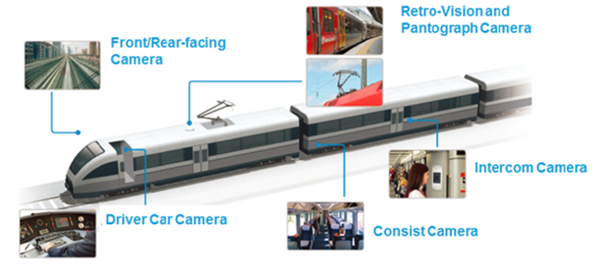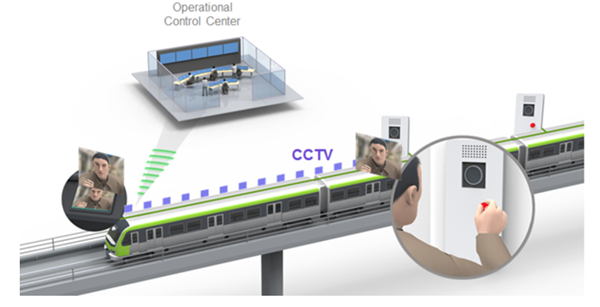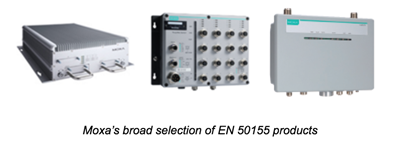IP-based CCTV systems are the defining factor in the success of modern train surveillance systems. In addition to ensuring passenger safety, these systems have expanded their scope and are now providing mission-critical information that will increase operational efficiency. IP-based cameras and NVR computing platforms are now being deployed in more and more locations throughout the rail system.
Although IP-based CCTV is almost a decade old, the technology has matured considerably in recent years, particularly with the deployment of high performance cameras. IP CCTV systems are also being deployed in more locations in train systems, affirming the need for better designs and higher performance. These new video surveillance applications demand high reliability from IP CCTV cameras and the underlying network infrastructure that supports the cameras. In addition, the cameras are also expected to deliver high definition video streams under harsh environmental conditions. Many of the modern IP CCTV cameras are deployed on existing networks that might limit the high-performance requirements of these cameras. Solutions that can strengthen the Train-to-Ground (T2G) networks are the most in-demand, as such networks can better utilize the next generation of high-performance IP CCTV cameras. In this article we look at the challenges faced by train operators and system integrators in deploying the next generation of video surveillance capabilities in rail systems.
Diverse Camera Deployment Locations and Day-and-Night Vision
Train operators can realize the full potential of IP CCTV cameras by increasing onboard camera coverage. IP cameras with various form factors, supporting different mounting needs, and that can be deployed in many diverse locations are needed to cover the entire train system. To add to this, IP CCTV in rail systems must deliver continuous performance and crystal-clear image quality in light as well as dark environments, regardless of their installation condition and their location. They are also expected to deliver good quality fast imaging in environments with quickly changing lighting conditions. For example, the transition from light to dark environments and back when the train goes through a tunnel should be smooth.

Vibration, Humidity, and Dust-Resistant IP Cameras for Harsh Onboard Environments
IP CCTV cameras for rail systems are also deployed in environments with extreme temperatures, humidity, vibration, or dust. Train operators expect to be able to monitor onboard conditions at all times, even when the train is on standby in a depot. For this reason, the cameras need to meet the EN 50155 T3 (-25 to 70°C) or TX (-40 to 70°C) class temperature requirements. Cameras used in trains should also have EMI and surge protection to ensure consistent performance and to prevent damage to the equipment. The minimum requirements for electromagnetic compatibility in railway applications are defined by EN 50121-3-2 or IEC 62232-3-2 standards. Since some of these cameras are used on the exterior of trains, they should also support a de-mist feature to deliver high quality images in rain and fog conditions. Secure and reliable disk access under extreme vibrations, as in the case of rolling stock, is absolutely essential for NVR computers to maintain data integrity and prevent data loss.
.png?width=400&height=87)
The Technology Gap
One of the biggest challenges in modern rolling stock systems is establishing a solid and dependable communications network between a fast-moving train and the stations along the track. Networks need to deliver high levels of bandwidth and availability in order to support CCTV, PA, alarm, and control systems, all on the same network. All of this must be achieved with a minimal increase in the total cost of ownership for the train operator. For example, automatic train operation systems rely on wireless train-to-ground communications so the central control room can directly control and manage onboard train operations.

Achieving a high level of performance on a rail network requires train operators to maintain a team of highly skilled IT networking professionals who can fine-tune the network to ensure high performance. This option in not feasible for most train operators as it is not their core competency. Managing such a team will also add to their operational cost. Network devices and systems that come with an industrial auto-configure function are a huge benefit to operators, especially to those who want to mass-deploy network devices. Intelligent technologies that can automatically reconfigure inter-consist network connections are highly sought after, especially in a scenario where consists are rearranged.
More ambitious operators are even looking ahead to providing passengers with onboard entertainment and Internet access in transit, which adds to the demand on the train-to-ground link. In order to meet these growing requirements, wireless devices must be able to consistently deliver sufficient bandwidth to support all of the emerging applications that count on train-to-ground communications. Fast and secure roaming with high throughput and millisecond-level handover time, and reliable networks for seamless exchange of data required for secure operations between the train and ground are the minimum capabilities sought in a T2G network.
The Challenge of Integrating Products from Different Vendors
Only a handful of vendors provide complete IP CCTV camera solutions for rail systems. This means that system integrators and operators have the difficult task of integrating these multi-vendor components into the underlying Ethernet network and making them work in tandem to derive the best performance possible. Besides, interoperability with existing systems is a challenge when refurbishing train systems. Railway industry standards such as EN 50155, IEC 62580-1, and IEC 60571 define the standards that products must adhere to for train systems, especially the requirements for rolling stock. Products that conform to these industry standards and deliver easy industrial auto-configure technology will go a long way in reducing configuration time, cost, and potential human error, so the system is both highly reliable and efficient to operate.
Complete EN 50155-Compliant Solution for Rolling Stock
Moxa’s comprehensive IP CCTV solutions include IP video products, network switches, wireless communications, video management software, and NVR platforms for rolling stock applications. Moxa’s portfolio includes a solution for every application and every installation environment. Moxa provides six different types of EN 50155-certified IP cameras that can be deployed as consist IP cameras, rear-view IP cameras, and also flush-mounted as hidden IP cameras. All six are rugged and come with M12 Ethernet connectors, PoE input, and comply with key EN 50155 and EN 50121-3-2 criteria. In addition, video resolution of up to 1920 x 1080 both in H.264 and MJPEG formats are available for live viewing and video recording.
For applications that need to operate in extreme temperatures, cameras are available with an optional -40 to 70°C operating temperature. These cameras are the first in the world to be compliant with the higher EN 50155 TX criteria. Moxa’s cameras do not use built-in heaters or fans, which eliminates a potential point of failure and delivers excellent product longevity of 10 to 20 years in rail applications.

In addition to IP cameras, Moxa provides EN 50155 M12 Ethernet switches, EN 50155 NVR, EN 50155 wireless APs, and computers. These products can be combined to create a complete EN 50155 IP CCTV system. To simplify configuration, all EN 50155 products are equipped with Moxa FLI™ configuration technology, which automates network settings and device configuration.

Visit the Moxa website for product details, or subscribe to our railway newsletter to stay up-to-date on the latest railway trends and learn about Moxa's newest IP-based solutions for rail applications.